Samsung B1630, B1730NW, B1930 Schematic
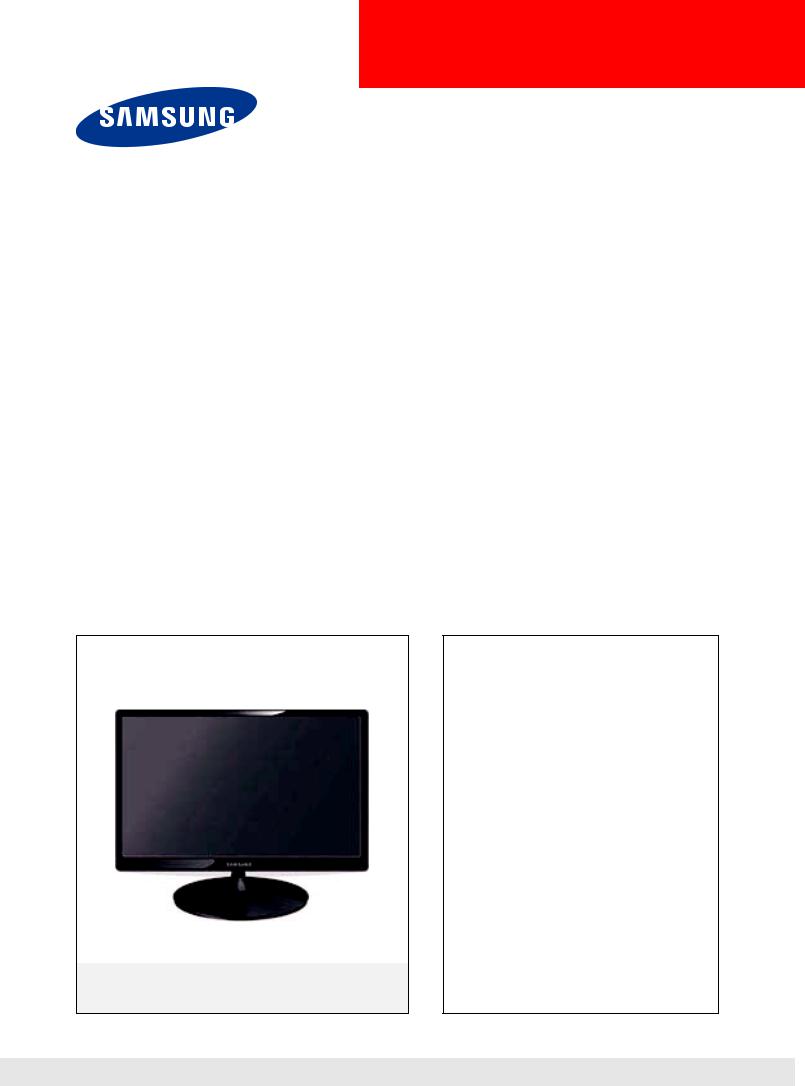
LCD-Monitor
Chassis : LPU16YS LPU17NS
LPU19YS / LPU19NS LPU20YS
LPU22YS
Model : B1630N B1730NW
B1930N / B1930NW B2030N
B2230N
SERVICE Manual 
TFT-LCD Monitor |
|
Contens |
|
|
|
1. Precautions
2. Product specifications
3. Disassembly and Reassemble
4. Troubleshooting
5. Exploded View & Part List
6. Wiring Diagram
B1630N / B1730NW / B1930N
B1930NW / B2030N / B2230N
Refer to the service manual in the GSPN (see the rear cover) for the more information.
Contents |
|
1. Precautions |
|
1-1. Safety Precautions.......................................................................................................... |
1-1 |
1-2. Servicing Precautions...................................................................................................... |
1-2 |
1-3. Static Electricity Precautions........................................................................................... |
1-2 |
1-4. Installation Precautions................................................................................................... |
1-3 |
2. Product specifications |
|
2-1. Feature & Specifications................................................................................................. |
2-1 |
2-2. Spec Comparison to the Old Models............................................................................... |
2-3 |
2-3. Accessories..................................................................................................................... |
2-5 |
3. Disassembly and Assembly |
|
3-1. Disassembly.................................................................................................................... |
3-1 |
4. Troubleshooting |
|
4-1. Troubleshooting............................................................................................................... |
4-1 |
4-2. When the Power Does Not Turn On................................................................................ |
4-2 |
4-3. When the screen is blank................................................................................................ |
4-4 |
4-4. Error Examples and Actions............................................................................................ |
4-8 |
4-5. Adjustment....................................................................................................................... |
4-9 |
5. Exploded View & Part List |
|
5-1. Exploded View................................................................................................................. |
5-1 |
5-2. Parts List (B1630N)......................................................................................................... |
5-2 |
5-3. Parts List (B1730NW)...................................................................................................... |
5-7 |
5-4. Parts List (B1930N)....................................................................................................... |
5-10 |
5-5. Parts List (B1930NW).................................................................................................... |
5-15 |
5-6. Parts List (B2030N)....................................................................................................... |
5-20 |
5-7. Parts List (B2230N)....................................................................................................... |
5-23 |
6. Wiring Diagram |
|
6-1. Wiring Diagram - Main Board.......................................................................................... |
6-1 |
6-2. Wiring Diagram - IP Board.............................................................................................. |
6-4 |
6-3. Connector Functions....................................................................................................... |
6-5 |
6-4. Cables............................................................................................................................. |
6-5 |
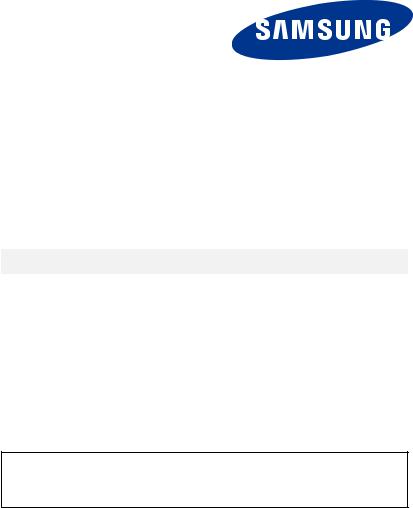
GSPN (Global Service Partner Network)
Area |
Web Site |
|
|
North America |
http://service.samsungportal.com |
|
|
Latin America |
http://latin.samsungportal.com |
|
|
CIS |
http://cis.samsungportal.com |
|
|
Europe |
http://europe.samsungportal.com |
|
|
China |
http://china.samsungportal.com |
|
|
Asia |
http://asia.samsungportal.com |
|
|
Mideast & Africa |
http://mea.samsungportal.com |
|
|
This Service Manual is a property of Samsung Electronics Co.,Ltd.
Any unauthorized use of Manual can be punished under applicable International and/or domestic law.
© 2009 Samsung Electronics Co.,Ltd. All rights reserved.
Printed in Korea
P/N: BN82-00841A-00

1. Precautions
1. Precautions
1-1. Safety Precautions
Follow these safety, servicing and ESD precautions to prevent damage and to protect against potential hazards such as electrical shock.
1-1-1. Warnings
1.For continued safety, do not attempt to modify the circuit board.
2.Disconnect the AC power and DC power jack before servicing.
1-1-2. Servicing the LCD Monitor
1.When servicing the LCD Monitor, Disconnect the AC line cord from the AC outlet.
2.It is essential that service technicians have an accurate voltage meter available at all times. Check the calibration of this meter periodically.
1-1-3. Fire and Shock Hazard
Before returning the monitor to the user, perform the following safety checks:
1.Inspect each lead dress to make certain that the leads are not pinched or that hardware is not lodged between the chassis and other metal parts in the monitor.
2.Inspect all protective devices such as nonmetallic control knobs, insulating materials, cabinet backs, adjustment and compartment covers or shields, isolation resistorcapacitor networks, mechanical insulators, etc.
3.Leakage Current Hot Check (Figure 1-1):
WARNING : Do not use an isolation transformer during this test.
Use a leakage current tester or a metering system that complies with American National Standards Institute (ANSI C101.1, Leakage Current for Appliances), and Underwriters Laboratories (UL Publication UL1410, 59.7).
(READING SHOULD)
NOT BE ABOVE 0.5mA
|
|
|
|
|
|
|
|
|
|
LEAKAGE |
|
DEVICE |
|
|
|
||
|
|
|
CURRENT |
||
UNDER |
|
|
|
||
|
|
|
TESTER |
||
TEST |
|
|
|
||
|
|
|
|
|
|
|
TEST ALL |
|
|
|
|
|
|
|
|
||
|
EXPOSED METAL |
|
|
|
|
|
SURFACES |
|
|
|
|
2-WIRE CORD |
|
|
|
||
*ALSO TEST WITH |
|
|
PLUG REVERSED |
|
|
(USING AC ADAPTER |
|
|
PLUG AS REQUIRED) |
EARTH |
|
|
|
|
|
GROUND |
Figure 1-1. Leakage Current Test Circuit |
|
|
4.With the unit completely reassembled, plug the AC line cord directly into a 120V AC outlet. With the unit’s AC switch first in the ON position and then OFF, measure the current between a known earth ground (metal water pipe, conduit, etc.) and all exposed metal parts, including: metal cabinets, screwheads and control shafts.
The current measured should not exceed 0.5 milliamp.
Reverse the power-plug prongs in the AC outlet and repeat the test.
1-1-4. Product Safety Notices
Some electrical and mechanical parts have special safetyrelated characteristics which are often not evident from visual inspection. The protection they give may not be obtained by replacing them with components rated for higher voltage, wattage, etc. Parts that have special safety characteristics are identified by  on schematics and parts lists. A substitute replacement that does not have the same safety characteristics as the recommended replacement part might create shock, fire and/or other hazards. Product safety is under review continuously and new instructions are issued whenever appropriate.
on schematics and parts lists. A substitute replacement that does not have the same safety characteristics as the recommended replacement part might create shock, fire and/or other hazards. Product safety is under review continuously and new instructions are issued whenever appropriate.
1-1

1. Precautions
1-2. Servicing Precautions
WARNING: An electrolytic capacitor installed with the wrong polarity might explode.
Caution: Before servicing units covered by this service manual, read and follow the Safety Precautions section of this manual.
Note: If unforeseen circumstances create conflict between the following servicing precautions and any of the safety precautions, always follow the safety precautions.
1-2-1 General Servicing Precautions
1.Always unplug the unit’s AC power cord from the AC power source and disconnect the DC Power Jack before attempting to:
(a) remove or reinstall any component or assembly, (b) disconnect PCB plugs or connectors, (c) connect a test component in parallel with an electrolytic capacitor.
2.Some components are raised above the printed circuit board for safety. An insulation tube or tape is sometimes used. The internal wiring is sometimes clamped to prevent contact with thermally hot components. Reinstall all such elements to their original position.
3.After servicing, always check that the screws, components and wiring have been correctly reinstalled. Make sure that the area around the serviced part has not been damaged.
4.Check the insulation between the blades of the AC plug and accessible conductive parts (examples: metal panels, input terminals and earphone jacks).
5.Insulation Checking Procedure: Disconnect the power cord from the AC source and turn the power switch ON.
Connect an insulation resistance meter (500 V) to theblades of the AC plug.
The insulation resistance between each blade of the AC plug and accessible conductive parts (see above) should be greater than 1 megohm.
6.Always connect a test instrument’s ground lead to the instrument chassis ground before connecting the positive lead; always remove the instrument’s ground lead last.
1-3. Static Electricity Precautions
Some semiconductor (solid state) devices can be easily damaged by static electricity. Such components are commonly called Electrostatically Sensitive Devices (ESD). Examples of typical ESD are integrated circuits and some field-effect transistors. The following techniques will reduce the incidence of component damage caused by static electricity.
1.Immediately before handling any semiconductor components or assemblies, drain the electrostatic charge from your body by touching a known earth ground. Alternatively, wear a discharging wrist-strap device. To avoid a shock hazard, be sure to remove the wrist strap before applying power to the monitor.
2.After removing an ESD-equipped assembly, place it on a conductive surface such as aluminum foil to prevent accumulation of an electrostatic charge.
3.Do not use freon-propelled chemicals. These can generate electrical charges sufficient to damage ESDs.
4.Use only a grounded-tip soldering iron to solder or desolder ESDs.
5.Use only an anti-static solder removal device. Some solder removal devices not classified as “anti-static” can generate electrical charges sufficient to damage ESDs.
6.Do not remove a replacement ESD from its protective package until you are ready to install it. Most replacement ESDs are packaged with leads that are electrically shorted together by conductive foam, aluminum foil or other conductive materials.
7.Immediately before removing the protective material from the leads of a replacement ESD, touch the protective material to the chassis or circuit assembly into which the device will be installed.
Caution: Be sure no power is applied to the chassis or circuit and observe all other safety precautions.
8.Minimize body motions when handling unpackaged replacement ESDs. Motions such as brushing clothes together, or lifting your foot from a carpeted floor can generate enough static electricity to damage an ESD.
1-2

1. Precautions
1-4. Installation Precautions
1.For safety reasons, more than two people are required for carrying the product.
2.Keep the power cord away from any heat emitting devices, as a melted covering may cause fire or electric shock.
3.Do not place the product in areas with poor ventilation such as a bookshelf or closet. The increased internal temperature may cause fire.
4.Bend the external antenna cable when connecting it to the product. This is a measure to protect it from being exposed to moisture. Otherwise, it may cause a fire or electric shock.
5.Make sure to turn the power off and unplug the power cord from the outlet before repositioning the product. Also check the antenna cable or the external connectors if they are fully unplugged. Damage to the cord may cause fire or electric shock.
6.Keep the antenna far away from any high-voltage cables and install it firmly. Contact with the highvoltage cable or the antenna falling over may cause fire or electric shock.
7.When installing the product, leave enough space (10cm) between the product and the wall for ventilation purposes.
A rise in temperature within the product may cause fire.
1-3

1. Precautions
Memo
1-4
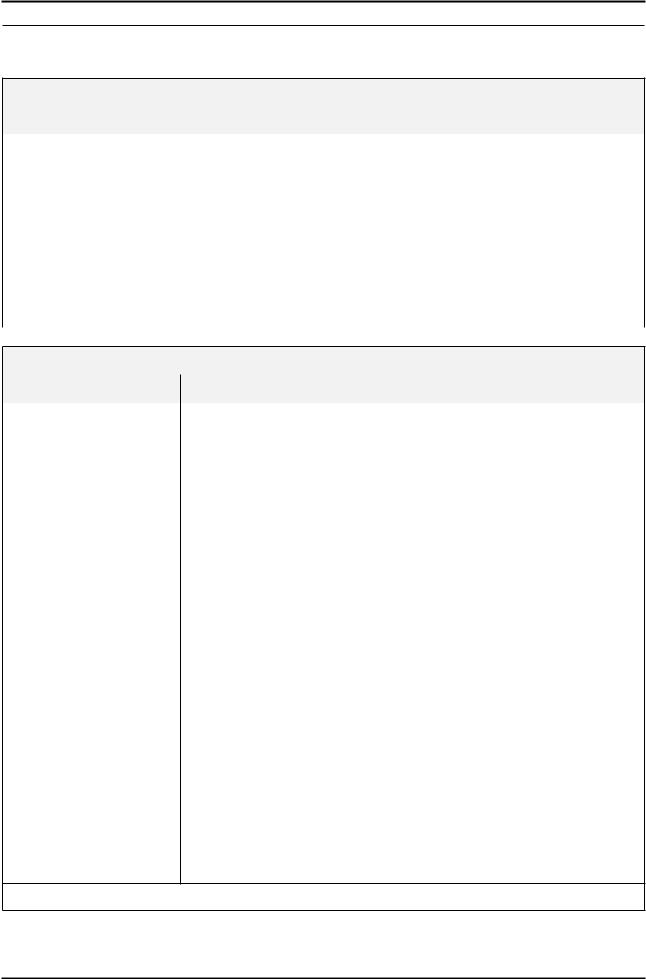
2. Product specifications
2. Product specifications
2-1. Feature & Specifications
Feature
Model |
B1630N |
B1730NW |
B1930N |
|
|
|
|
Brightness(Typical) |
250 cd/m2 |
250 cd/m2 |
250 cd/m2 |
|
|
|
|
Response Time(Typical) |
5ms |
5ms |
5ms |
|
|
|
|
Contrast Ratio(Typical) |
DC 50000:1 |
DC 50000:1 |
DC 50000:1 |
|
(Typ.500:1) |
(Typ.600:1) |
(Typ. 1000:1) |
|
|
|
|
Viewing Angle |
90˚/ 65˚ (CR>10) |
160˚/150˚ (CR>10) |
170˚/160˚ (CR>10) |
(Horizontal/Vertical) |
|
|
|
|
|
|
|
Stand by Power(DPMS) |
<0.3W |
<0.3W |
<0.3W |
|
|
|
|
Special Features |
MagicBright3, MagicEco, MagicAngle, Off timer, Image Size, |
||
|
Color Effect,Customized key, Windows Vista Basic |
||
|
|
|
|
Specifications
Model |
B1630N |
B1730NW |
B1930N |
|
|
|
|
|
|
|
TFT-LCD panel, RGB vertical stripe, normally white transmissive |
|||
|
|
|
|
|
LCD Panel |
15.6”Wide |
17”Wide |
18.5”Wide |
|
|
0.252 mm(H) x 0.252 mm(V) |
0.255 mm(H) x 0.255 mm(V) |
0.3 mm(H) x 0.3 mm(V) |
|
|
pixel pitch |
pixel pitch |
pixel pitch |
|
|
|
|
|
|
Scanning Frequency |
Horizontal:30 ~ 61 kHz |
Horizontal:30 ~ 81 kHz |
Horizontal:31 ~ 80 kHz |
|
Vertical:56 ~ 75 Hz |
Vertical:56 ~ 75 Hz |
Vertical:56 ~ 75 Hz |
||
|
||||
|
|
|
|
|
Color Supported |
|
16.7M |
|
|
|
|
|
|
|
Resolution |
1360 x 768 |
1440 x 900 |
1360 x 768 |
|
|
|
|
|
|
Input Signal |
15.6” Analog |
17” Analog |
18.5” Analog |
|
|
|
|
|
|
Input Sync. Signal |
Separate H/V sync, Composite H/V, Sync-on-Green |
|||
|
Level:TTL level |
|
||
|
|
|
||
|
|
|
|
|
Maximum Pixel Clock |
90 MHz |
136.75 MHz |
89 MHz |
|
|
|
|
|
|
Active Display |
344.232(H) x 193.536(V) |
367.2(H) x 229.5(V) |
409.8(H) x 230.4(V) |
|
(Horizontal/Vertical) |
||||
|
|
|
||
|
|
|
|
|
AC power voltage & Frequency |
AC 110~130V, 60Hz & AC 200~240V, 50Hz |
|||
|
|
|
|
|
Power consumption |
Less than 22W |
Less than 22W |
Less than 22W |
|
|
|
|
|
|
Dimension Set |
388 x 338 x 178mm |
413 x 375 x 178mm |
455.6 x 375 x 178mm |
|
(W x H x D) |
|
|||
|
|
|
||
|
|
|
|
|
Weight |
2.65kg |
2.9kg |
3.55kg |
|
|
|
|
|
|
Operating Temperature: 10˚C ~ 40˚C(50˚F ~ 104˚F)
Environmental Considerations Operating Humidity : 10% ~ 80% Operating Temperature: -25˚C ~ 45˚C(-13˚F ~ 113˚F)
Operating Humidity: 5% ~ 90%
Note: Designs and specifications are subject to change without prior notice.
2-1

2. Product specifications
Feature
Model |
B1930NW |
B2030N |
B2230N |
|
|
|
|
|
|
Brightness(Typical) |
300 cd/m2 |
250 cd/m2 |
300 cd/m2 |
|
|
|
|
|
|
Response Time(Typical) |
5ms |
5ms |
5ms |
|
|
|
|
|
|
Contrast Ratio(Typical) |
DC 70000:1 |
DC 50000:1 |
DC 70000:1 |
|
|
(Typ. 1000:1) |
(Typ. 1000:1) |
(Typ. 1000:1) |
|
|
|
|
|
|
Viewing Angle |
160˚/160˚ (CR>10) |
170˚/160˚ (CR>10) |
170˚/160˚ (CR>10) |
|
(Horizontal/Vertical) |
||||
|
|
|
||
|
|
|
|
|
Stand by Power(DPMS) |
<0.3W |
<0.3W |
<0.3W |
|
|
|
|
|
|
Special Features |
MagicBright3, MagicEco, MagicAngle, Off timer, Image Size, |
|||
|
Color Effect,Customized key, Windows Vista Basic |
|||
|
|
|
|
|
Specifications
Model |
B1930NW |
B2030N |
B2230N |
|
|
|
|
|
|
|
TFT-LCD panel, RGB vertical stripe, normally white transmissive |
|||
|
|
|
|
|
LCD Panel |
19”Wide |
20” Wide |
21.5” Wide |
|
|
0.2835 mm(H) x 0.2835 mm(V) |
0.2768 mm(H) x 0.2768 mm(V) |
0.24825 mm(H) x 0.24825 mm(V) |
|
|
pixel pitch |
pixel pitch |
pixel pitch |
|
|
|
|
|
|
Scanning Frequency |
Horizontal:30 ~ 81 kHz |
Horizontal:30 ~ 81 kHz |
Horizontal:31 ~ 80 kHz |
|
Vertical:56 ~ 75 Hz |
Vertical:56 ~ 75 Hz |
Vertical:50 ~ 75 Hz |
||
|
||||
|
|
|
|
|
Color Supported |
|
16.7M |
|
|
|
|
|
|
|
Resolution |
1440 x 900 |
1600 x 900 |
1920 x1 080 |
|
|
|
|
|
|
Input Signal |
19” Analog |
20” Analog |
21.5” Analog |
|
|
|
|
|
|
Input Sync. Signal |
Separate H/V sync, Composite H/V, Sync-on-Green |
|||
|
Level:TTL level |
|
||
|
|
|
||
|
|
|
|
|
Maximum Pixel Clock |
137 MHz |
150 MHz |
162 MHz |
|
|
|
|
|
|
Active Display |
408.24(H) x 255.15(V) |
442.8(H) x 249.075(V) |
476.64(H) x 268.11(V) |
|
(Horizontal/Vertical) |
||||
|
|
|
||
|
|
|
|
|
AC power voltage & Frequency |
AC 110~130V, 60Hz & AC 200~240V, 50Hz |
|||
|
|
|
|
|
Power consumption |
Less than 39W |
Less than 28W |
Less than 50W |
|
|
|
|
|
|
Dimension Set |
458 x 402 x 178mm |
492 x 396 x 178mm |
523.4 x 400 x 197mm |
|
(W x H x D) |
||||
|
|
|
||
|
|
|
|
|
Weight |
3.95kg |
4.1kg |
4.35kg |
|
|
|
|
|
|
Operating Temperature: 10˚C ~ 40˚C(50˚F ~ 104˚F)
Environmental Considerations Operating Humidity : 10% ~ 80% Operating Temperature: -25˚C ~ 45˚C(-13˚F ~ 113˚F)
Operating Humidity: 5% ~ 90%
Note: Designs and specifications are subject to change without prior notice.
2-2
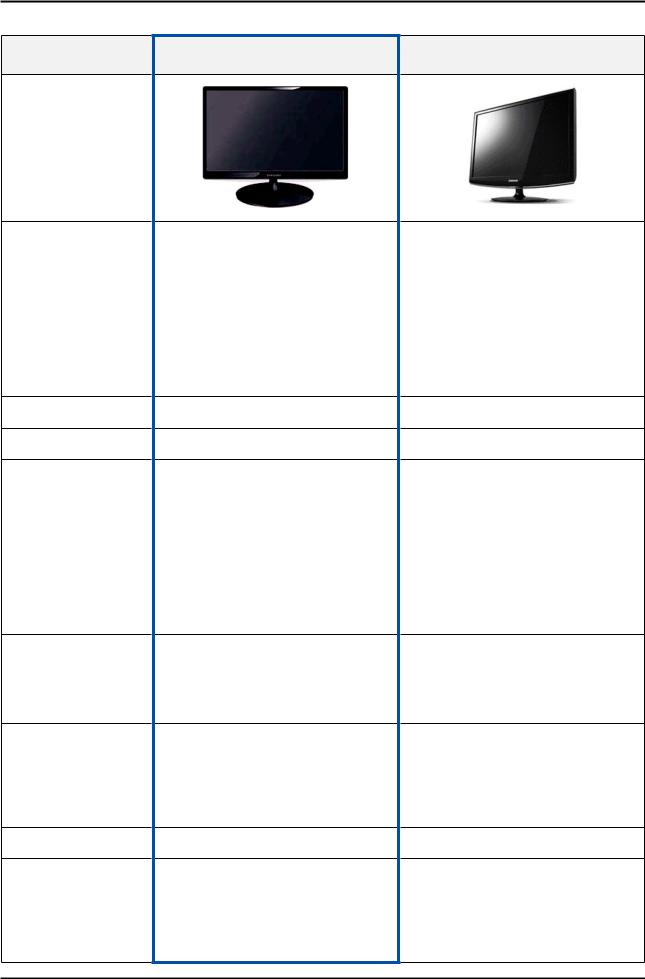
2. Product specifications
2-2. Spec Comparison to the Old Models
Model
Design
Resolution
Input
Response Time
Viewing Angle
Brightness
Contrast
MagicBright
Feature
B1630N / B1730NW / B1930N / B1930NW / B2030N / B2230N
1360 x 768 (B1630N/B1930N)
1440 x 900 (B1730NW/B1930NW)
1600 x 900 (B2030N)
1920 x 1080 (B2230N)
Analog
5ms
90/65(CR>10)
(B1630N)
160/150(CR>10)
(B1730NW)
160/160(CR>10)
(B1930NW)
170/160(CR>10)
(B1930N/B2030N/B2230N)
250 m²
(B1630N/B1730NW/B1930N/B2030N)
300 m²
(B1930NW/B2230N)
50,000:1(DC)
(B1630N/B1730NW/B1930N/B2030N)
70,000:1(DC)
(B1930NW/B2230N)
4 Step
MagicBright3
MagicEco
MagicAngle
Off timer
Image Size
Color Effect
633NW / 733NW / 933SN / 933NW / 2033SN / 2233SN
1360 x 768 (633NW/933SN)
1440 x 900 (733NW/933NW)
1600 x 900 (2033SN)
1920 x 1080 (2233SN)
Analog
5ms
90/65(CR>10)
(633NW)
160/150(CR>10)
(733NW)
160/160(CR>10)
(933NW)
170/160(CR>10)
(933SN/2033SN/2233SN)
250 m²
(633NW/733NW/933SN/2033SN)
300 cm²
(933NW/2233SN)
12,000:1(DC) (633NW)
15,000:1(DC) (733NW)
50,000:1(DC)
(933SN/933NW/2033SN/2233SN)
7 step
MagicBright3
Off timer
Image Size
Color Effect
2-3

2. Product specifications
*Color Effect
-Grey scale: Images are displayed in a grey tone on the screen.
-Green: Images are displayed in a green tone on the screen.
-Aqua: Images are displayed in a blue tone on the screen.
-Sepia: Images are displayed in a brown tone on the screen.
Image Size : If the resolution is not wide resolution, this option allows the screen size to be selected as normal or wide.
*MagicAngle
-Lean Back Mode1: Select when viewing from a slightly lower angle.
-Lean Back Mode2: Select when viewing from the bottom.
-Standing Mode: Select when viewing from the top.
-Side Mode: Select when viewing from the left or right.
-Custom: When <Custom> is selected, settings for <Lean Back Mode 1> is applied by default. User can set suitable picture quality as needed.
*MagicEco
-100%: the power consumption is 100% of Default Setting.
-75%: the power consumption is 75% of Default Setting.
-50%: the power consumption is 50% of Default Setting.
2-4

2-3. Accessories |
User’s Guide, |
|
2. Product specifications |
|
Monitor Driver, |
BN59-00982A |
|||
Natural Color Pro Software |
|
|||
D-sub Cable |
BN39-00244G |
|||
1,500mm(1.5M) |
||||
|
||||
Power Cord |
3903-000452 |
|||
1,830mm(1.8M) |
||||
|
||||
Cleaning Cloth |
BN63-02368B |
|||
160mm x 120mm |
|
|||
Product |
Description |
Ccde. No |
Remark |
|
|
Quick Setup Guide |
BN68-02480A |
|
|
|
Warranty Card |
BN68-00226R |
|
|
|
(Not available in all locations) |
|
|
|
|
|
|
Samsung Electronics |
|
|
|
|
Service center |
2-5

2. Product specifications
Memo
2-6
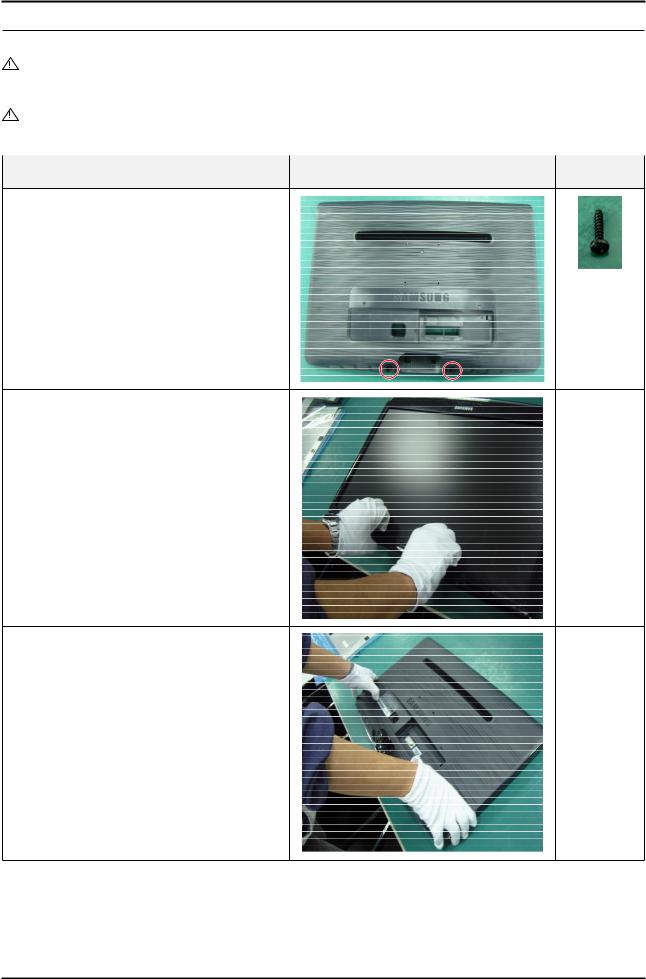
3. Disassembly and Assembly
3. Disassembly and Assembly
This section describes the disassembly and reassembly sequences for this monitor.
Warning: |
As this monitor has parts that are sensitive to static electricity, be careful when handling them. |
|
||
3-1. Disassembly |
|
|
||
Caution: |
1. Turn the monitor off before beginning the disassembly process. |
|
||
|
2. |
When disassembling the monitor, do not use any metal tools except for the provided jig. |
|
|
|
3. |
Disassemble the monitor carefully as directed in the following procedures. |
|
|
|
|
|
|
|
|
|
Description |
Photo |
Screws |
1.Remove the stand body and then remove the two
(2) screws shown in the figure.
2.Turn the monitor over and insert your hands into the top of the monitor at the center and separate the front cover in the direction of the arrow as shown in the figure.
Separate the sides of the front cover up to the directed line as shown in the figure.
3.Turn the monitor over again to remove the back cover.
3-1
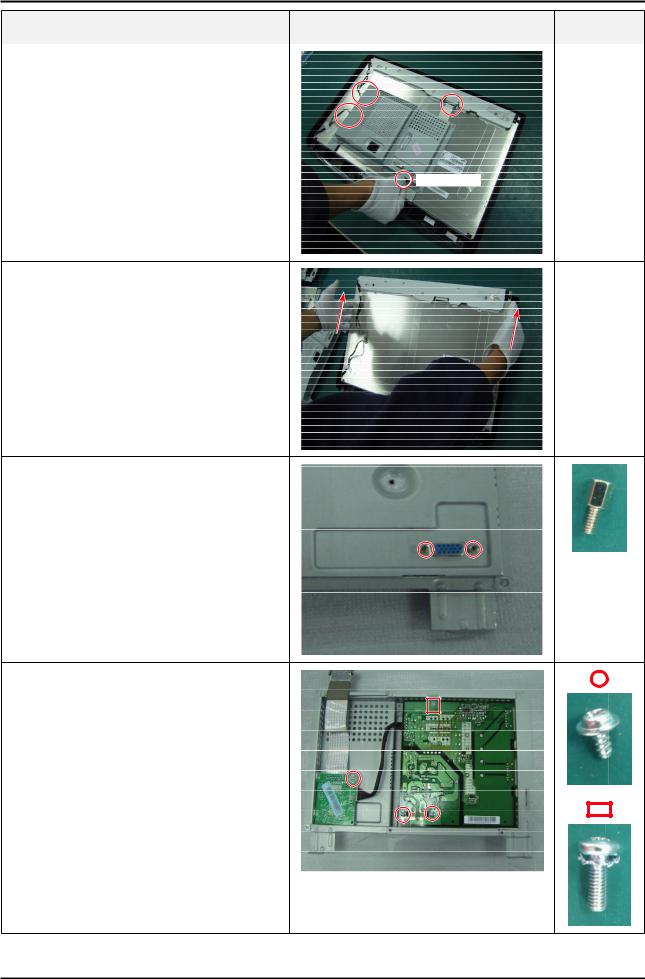
3. Disassembly and Assembly
Description |
|
Photo |
|
Screws |
|
|
|
|
|
4. Remove the LVDS, LAMP wire and FUNCTION |
|
|
|
|
cable then remove the SHIELD-COVER. |
|
|
|
|
LAMP |
|
|
|
|
|
|
|
|
|
|
WIRE |
|
|
|
|
|
|
LVDS |
|
FUNCTION
5. Remove the LCD panel.
6. Remove the two (2) screws shown in the figure.
7.Remove the four (4) screws shown in the figure and remove the Bracket support.
3-2

|
|
|
3. Disassembly and Assembly |
|
|
|
|
|
|
|
|
Description |
|
Photo |
Screws |
|
|
|
|
8. Remove the main PCB and IP boards from the |
|
|
|
IP-BOARD |
|
|
|
SHIELD-cover. |
|
|
|
|
|
|
MAIN-BOARD
The assembly is in the reverse order of disassembly.
3-3
